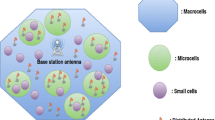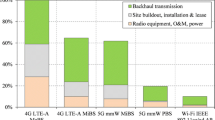Abstract
The current evolution of mobile broadband is expected to significantly increase the demand for wireless access resources in the near future. In this article, three ways to escape this wireless access bottleneck trap are examined. The first option is technologically driven and corresponds to enhancing the spectral efficiency of access technology, thus making better use of available wireless resources. However, there are theoretical limits for this approach, and further improvements might be complex and costly. The second option is based on allocating additional spectrum for mobile applications. Here, the “digital dividend” provides a unique opportunity, but the corresponding process is lengthy due to the required international harmonization. The third option focuses on densification of access points, which usually requires considerable investments. However, user provided small cell networks could provide an ingenious way out of the trap. Finally, the three options are compared, and drivers and barriers for the different approaches are analyzed.
Zusammenfassung
Die derzeitigen Entwicklungen auf dem Gebiet des mobilen Breitbands lassen eine weitere deutliche Steigerung der Nachfrage nach Ressourcen in drahtlosen Zugangsnetzen für die nahe Zukunft erwarten. Der vorliegende Artikel analysiert drei unterschiedliche Optionen zur Beseitigung dieser Ressourcenknappheit. Der erste Ansatz ist stark technologiegetrieben und läuft auf die weitere Steigerung der spektralen Effizienz hinaus, um eine bessere Nutzung vorhandener Ressourcen im Zugangsnetz zu ermöglichen. Hierfür gibt es jedoch theoretische Grenzen, und Verbesserungen hier können sich durchaus als komplex und kostspielig herausstellen. Alternativ dazu ist die Zuteilung von zusätzlichem Spektrum vorstellbar. In diesem Zusammenhang stellt die so genannte „Digitale Dividende“ eine einzigartige Gelegenheit dar, wobei allerdings die damit zusammenhängenden Prozesse langwierig sind und eine Harmonisierung auf internationalem Gebiet erfordern. Drittens schließlich könnte man die räumliche Dichte der Zugangsknoten erhöhen – üblicherweise ebenfalls mit erheblichen Kosten verbunden. Hier allerdings könnte die Einbindung von endnutzerbetriebenen so genannten „Small Cell“-Netzen einen unerwartet einfachen Weg aus der Problematik bereitstellen. Die drei Optionen werden abschließend miteinander verglichen, um die jeweiligen Technologietreiber bzw. -barrieren herauszustellen.


Similar content being viewed by others
Notes
See www.gsacom.com/.
See e.g. ITU 2011 Figure 1.1.
In the case of Austria, RTR Telekom Monitor 1/2012 page 38 shows that already 60 % of all broadband connections are mobile.
See e.g. http://en.wikipedia.org/wiki/Spectral_efficiency for a survey table of spectral efficiency of current mobile networking technologies/.
See also Mecklenbräuker et al. (2011).
The targets for average spectrum efficiency of LTE-Advanced are defined in 3GPP TR 36.913, Table 8.1. For instance the target for downlink spectrum efficiency for antenna configuration 4×4 is 3.7 bps/Hz/cell. The target for peak spectrum efficiency in the downlink is 30 bps/Hz.
See www.netindex.com/.
Cf. Cisco Visual Networking Index (VNI).
The frequency bands defined for GSM technology are listed in 3GPP TS 45.005 (2011).
See e.g. the study (ARGE ABI 2010) commissioned by the Austrian regulatory authority RTR.
See: European Commission Decision 2010/267/EU.
WRC-12: Resolution COM5/10.
See European Commission Decision 2009/766/EC for the usage of other terrestrial systems in the 900 and 1800 MHz band.
See http://www.fon.com/.
References
3GPP TS 45.005 (2011): Radio transmission and reception. Version 10.3.0, Dec. 2011.
ARGE ABI (2010): Die Nutzung der digitalen Dividende in Österreich. 27. April 2010.
European Commission Decision (2009/766/EC) on the harmonisation of the 900 MHz and 1 800 MHz frequency bands for terrestrial systems capable of providing pan-European electronic communications services in the Community. 16.10.2009.
European Commission Decision (2010/267/EU) on harmonised technical conditions of use in the 790–862 MHz frequency band for terrestrial systems capable of providing electronic communications services in the European Union. 06.05.2010.
Feiel, W. (2010): Mobile broadband—a substitute for fixed? Presentation held at the 25the ANACOM seminar, Lisbon, 15.04.2010.
Fuxjäger, P., Gojmerac, I., Fischer, R., Reichl, P. (2011): Measurement-based small-cell coverage analysis for urban macro-offload scenarios. In Proc. IEEE 73rd vehicular technology conference (VTC2011-Spring), BeFEMTO Workshop, Budapest, Hungary, May 2011.
Fuxjäger, P., Fischer, H. R., Gojmerac, I., Reichl, P. (2010): Radio resource allocation in urban Femto-WiFi convergence scenarios. In Proc. 6th Euro-NF conference on next generation internet (NGI’10), Paris, France, June 2010.
ITU (2011): Trends in telecommunication reform 2010/2011—enabling tomorrow’s digital world. ITU, March 2011.
Mecklenbräuker, C., Gaigg, P., Ruhle, E.-O., Reichl, W., Malleck, H., Lundborg, M., Berger, E. (2011): Frequenzverteilungsuntersuchung der möglichen Flexibilisierung im 900/1800 MHz Band. Bundesnetzagentur, Abschlussbericht 25.03.2011.
Reichl, P., Gojmerac, I., Barth, D., Krichen, M., Cohen, J., Marcé, O., Wiedermann, W. (2011): Techno-economics of small cell networks: the AWARE project. In Proc. international conference on NETwork Games, COntrol and OPtimization (NetGCooP’11), Paris, France, October 2011.
RTR Telekom Monitor 1/2012.
Rysavy Research (2010): Transition to 4G—3GPP Broadband evolution to IMT advanced. 3G Americas, September 2010.
SBR Juconomy Consulting (2009): Evaluation of the technical and economic consequences for cable TV operators if the digital dividend is allocated to the mobile sector. 24. September 2009.
Wolff, I. (2010): Zukünftige Trends in der mobilen Kommunikation. Fachforum “mobile communication”. Paderborn, 29. September 2010.
Acknowledgements
Part of this work has been funded by the Austrian Government and the City of Vienna within the COMET program; further support from Université Européenne de Bretagne and Télécom Bretagne Rennes as well as LAAS-CNRS Toulouse, France and the Department of Communications and Networking, Aalto University Helsinki, Finland, is gratefully acknowledged. The authors would like to cordially thank Paul Fuxjäger for his extremely helpful input, and Ivan Gojmerac, Ronny Fischer and Olivier Marcé together with the entire AWARE team as well as Helmut Malleck and Olav Ruhle for many interesting and fruitful discussions.
Author information
Authors and Affiliations
Corresponding author
Additional information
Authors are listed in reverse alphabetical order.
Rights and permissions
About this article
Cite this article
Reichl, W., Reichl, P. & Reichel, P. Out of the wireless access bottleneck trap: technologies, economics, regulation and standardization perspectives. Elektrotech. Inftech. 129, 400–406 (2012). https://doi.org/10.1007/s00502-012-0056-6
Received:
Accepted:
Published:
Issue Date:
DOI: https://doi.org/10.1007/s00502-012-0056-6
Keywords
- mobile broadband
- digital dividend
- wireless access resources
- 3G
- 4G
- LTE
- GSM
- UMTS
- FON
- small cell networks
- femto cells, WiFi aggregation




